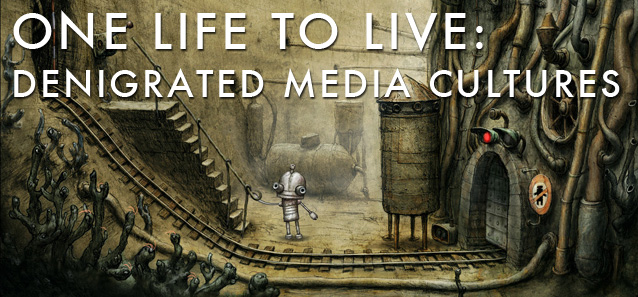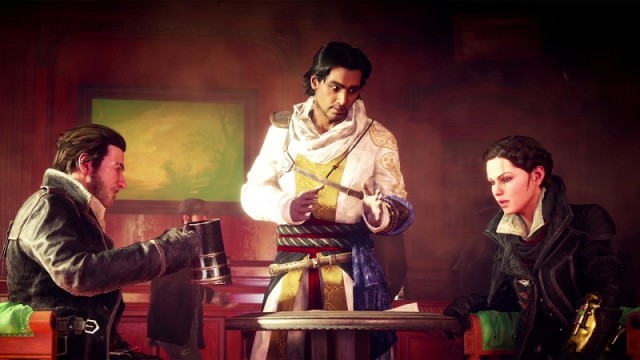


For many reasons, the subjects of video games and soap operas rarely overlap. If anything, games and soaps might be thought of as forms having little in common. Soap operas are a television genre largely associated with long-term character development spanning decades, domestic drama, and the housewife audience. In contrast, video games are a medium onto themselves, rarely attempt character development, often stay away from domestic issues in narrative, and are associated with a young male audience. However, the two media forms have one central thing in common. Both are denigrated in popular culture, one thought of as the pastime of idle, stay-at-home mothers, the other the pastime of equally idle, immature man-boys. And you thought you had nothing in common.
...soaps and games have found commonality at the bottom of the totem pole, in the sewage that is often understood as “lowbrow” entertainment.In a hierarchical cultural system that privileges some media forms while condemning others, soaps and games have found commonality at the bottom of the totem pole, in the sewage that is often understood as “lowbrow” entertainment.
Associate Professor at the University of Wisconsin-Milwaukee in the Dept. of Journalism, Advertising, and Media Studies, Elana Levine is familiar with the low cultural position of soap operas and video games. While not the biggest gamer, she is an avid fan of the soap opera genre.
“Both of these cultural products are associated with social groups that do not typically have a lot of power, authority, or respect in our society, and that leads to their denigration,” says Levine. “Because soaps are associated with women, and more specifically with women who are home during the day to watch them, they carry with them many of our culture's negative connotations about private vs. public work and gender. I think video games' association with youth is the source of the medium's denigration. Because they are games, the implication is that they are not serious or important, that they are juvenile.”
Believe it or not, Shakespeare used to be enjoyed by everybody, not just pretentious literary folk.Cultural or taste hierarchy is most often distinguished along the highbrow/lowbrow binary. Occasionally these terms are substituted for words such as “elitist” or “mass” culture. In his book, Highbrow/Lowbrow: The Emergence of Cultural Hierarchy in America, a different Levine, Lawrence Levine, traces the origins of these distinctions to developments in the 19th century that began to solidify class identity. Believe it or not, Shakespeare used to be enjoyed by everybody, not just pretentious literary folk. The categorization of cultural products that developed during this time can be understood as serving one main function: class distinction.
In order to maintain and exercise power over the masses, the upper class adopted an Arnoldian concept of culture, culture with a big “C.” Matthew Arnold believed that true culture, what we might think of as high art, is “everything that is uplifting and edifying,” everything that calls attention to the greatness of mankind. Think classical music. Think the master painters. While nested in high-minded philosophizing, Arnold really just wanted to introduce criteria for cultural products that distanced the tastes of the masses from the tastes of society’s wealthiest in education and capital.
He wanted to feel special.
The point is what we think of as distinctions between legitimate and illegitimate culture, between Mad Men and General Hospital, between Citizen Kane and Call of Duty, is actually just a way to legitimize power of one group over another. And this works in ways beyond class. Taste distinctions are also formed around categories of gender, race, and age, among others.
Knowing this, it is little surprise that soaps are positioned as cheap, mass culture. As Elana Levine reminds us, they are associated with women who are home during the normal workday. Not only are soaps connected with the feminine, perpetually subordinated by the masculine in our patriarchal society, they are also associated with the un(der)employed, a position always disparaged in our culture that champions capitalistic values.
Video games do not have it quite as bad. Popularly linked with young, underemployed males unable or unwilling to give up the pleasures of youth, video games are perpetually stuck in the popular imagination as a child’s hobby. But at least video games have their masculine gendering as a foundation on which to build a sense of legitimacy.
Denigration “doesn't seem to bother soap fans all that much,” says Levine. “They're probably used to it. While gamers might have a hard time dealing with cultural dismissal, given the more typically powerful position of masculinity.”
Whether you side in one camp or another, it is clear that many gamers want to argue video games are an art.We can see just how hard of a time gamers have with this dismissal in the proverbial debate surrounding games as art. Whether you side in one camp or another, it is clear that many gamers want to argue video games are an art. This goes beyond a personal commitment to the medium. It is also about power and legitimacy. It is about saving video games from the same cultural ghetto that soap operas and comic books have resided in for over half a century.
Despite their different gendered associations and forms, games and soaps are both victims of extensive stereotyping.
“The stereotype about soaps is that they are over-acted, poorly produced, unrealistic, histrionic, etc.,” says Levine. “But they're really no different than any other cultural product, once you are familiar with them. It's all about accepting the conventions of the genre.” Games too suffer from a wildly inaccurate cultural misconception.
“Someone unfamiliar with video games would surely also find them odd or difficult to like or boring,” says Levine. “All media forms and genres have conventions that we learn to accept and understand once we are immersed in them but that can seem strange or off-putting from the outside.”
The next time somebody brings up soap operas, Justin Bieber, or the newest Tyler Perry movie, instead of making fun of them, try to understand where they are coming from.As much as gamers decry the low cultural status of their chosen hobby and the way games are often misrepresented in the news, many of these same people probably do not think twice when passing judgment on other cultural forms and texts. The next time somebody brings up soap operas, Justin Bieber, or the newest Tyler Perry movie, instead of making fun of them, try to understand where they are coming from. Try to remember there are people who see games as just as frivolous, just as juvenile, just as irrelevant. Try to see how soaps and video games are really not that different, at least in terms of their position within cultural hierarchy.
Try to resist the urge to perpetuate distinctions that serve only to empower some while denigrating others.
Finally, try to remember that culture is always changing. And as many of us know, video games are becoming more and more accepted as a mainstream entertainment medium.
“Given the contemporary decline of soaps and rise of video games as prominent cultural forms,” says Levine, “I think that gaming is much more quickly shedding negative associations than is (or probably ever will) soap operas. This may be because of the immense power of gender as a cultural category. Even if they are associated with youth, video games are also associated with masculinity, and that inherently gives them more power than a form associated with the feminine in a culture of continuing gender inequality.”




 MGS5 The Phantom Pain: New DLC - outfits Overview
MGS5 The Phantom Pain: New DLC - outfits Overview Empyrion Galactic Survival (PC) tips
Empyrion Galactic Survival (PC) tips Super Smash Bros Wii U: Advanced Greninja Combo Guide
Super Smash Bros Wii U: Advanced Greninja Combo Guide How Microsoft's Move Into Open Source Is Affecting You
How Microsoft's Move Into Open Source Is Affecting You Sequence 3 - Somewhere That's Green: Assassin's Creed: Syndicate Walkthrough
Sequence 3 - Somewhere That's Green: Assassin's Creed: Syndicate Walkthrough